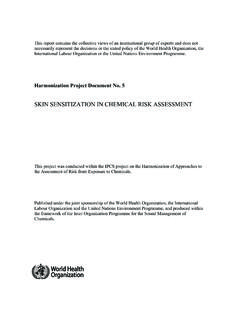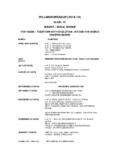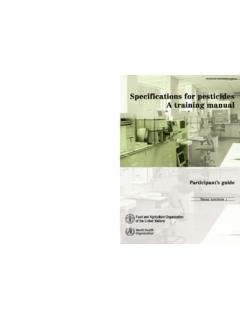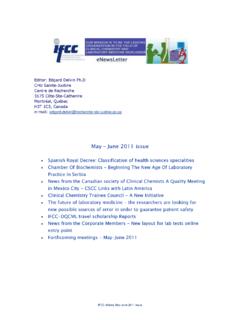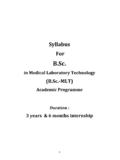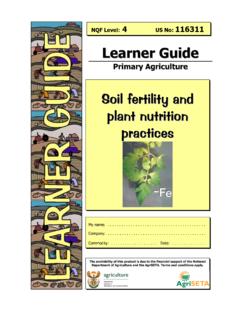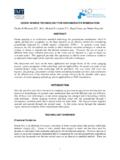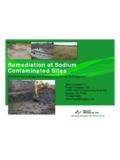Transcription of CALL FOR DATA ON CIGUATERA FISH POISONING - fao.org
1 CALL FOR data ON CIGUATERA fish POISONING . Deadline: 1 May 2018. Background CIGUATERA fish POISONING (CFP) is one of the most common food-borne illnesses related to seafood consumption. While CFP has been known for centuries, its true incidence remains unclear; few years ago, it was estimated that 10 000 50 000 people per year suffer from this illness (Lehane, L. 2000) 1. CFP is caused by the consumption of herbivorous fish that have become toxic from feeding on toxic benthic dinoflagellates (Gambierdicus toxicus) or from carnivorous fish that have consumed toxic herbivorous fish that have fed on dinoflagellates. According to a report published by FAO in 2004 2, more than 400 species of fish are known to be vectors of CIGUATERA , and Gambierdicus toxicus is found primarily in the tropics in association with macro algae usually attached to dead corals.
2 The same report concluded that the available data on ciguatoxins (CTXs) were not suitable for risk assessment. In a further FAO publication from 2014 3, CIGUATERA dinoflagellates were predicted to become one of the increasing food safety threats due to climate change. In 2015, FAO organized an interagency meeting 4 to discuss CIGUATERA fish POISONING as an increasing food safety threat. During the meeting a plan of action was defined and the need of international level guidance was identified. At the 32nd Session of the Codex Committee on Fisheries and Fishery Products (2016), CFP was raised by the Pacific Nations as an issue that increasingly affects the tropical and subtropical regions of the Pacific Ocean, Indian Ocean, and Caribbean Sea, between the latitudes 35 N and 35 S.
3 Indeed, it was noted that due to climate change the frequency of storms and hurricanes increases as well as the sea surface temperature (SST), which impacts on the distribution and proliferation of CTXs and makes the occurrence of CFP less predictable. In addition to climate change, globalization of trade might also contribute to the spread of CTX. As such, further guidance might be needed for those countries that did not consider ciguatoxins in their risk management programs in the past. 1. Lehane, L. 2000. CIGUATERA update. Med. J. Aust. 172(4): 176-179. 2 FAO Food and Nutrition Paper 80 Marine Biotoxins ( ), providing basic information about CIGUATERA , including: chemical structures and properties of ciguatoxins, methods of analysis, source, habitat and distribution, occurrence and accumulation in seafood, toxicity, prevention of intoxication, a summary of cases and outbreaks of CIGUATERA fish POISONING (CFP) and regulations.
4 3 FAO Fisheries and Aquaculture Technical Paper 574, Assessment and management of seafood safety and quality . ( ). 4 Together with the World Health Organization (WHO), UNESCO's Intergovernmental Oceanographic Panel on Harmful Algal Blooms (UNESCO-IOC), and the International Atomic Energy Agency (IAEA) ( CIGUATERA - fish - POISONING -requires-broad- partnerships/en/). 1. CFP was raised at the Codex Committee on Contaminants in Food at its 11th Session (CCCF11 1 ). The Committee agreed to request scientific advice from FAO/WHO to allow the development of appropriate risk management options. In particular, the requested scientific advice to FAO/WHO entails: full evaluation of known CTXs (toxicological assessment and exposure assessment), including geographic distribution and rate of illness; congeners; methods of detection; and based on this, guidance for the development of risk management options Objective of this call The data will serve as inputs to the development of scientific advice, which shall be provided through an expert consultation that will take place in Rome on 19-23 November 2018 and will guide the elaboration of appropriate Codex texts and advise Member States.
5 Request for relevant information FAO and WHO want to ensure that all available and relevant information and data are collected, and are requesting governments, private sector, the food industry, academia, consumer groups, laboratories, health care providers, climate change and marine environment and biology specialist, fishers and any other interested organizations and individuals to submit any available data on the specific areas indicated. These data may be published or unpublished. Reference should be made to related published studies, where applicable. Deadline for submission of data Please submit any relevant information by 1 May 2018 in any format (electronic and/or hard copies - electronic submissions are preferred, either via e-mail (if not too large) or on USB key), in any official United Nations (UN) language (English, French, Spanish, Arabic, Chinese, Russian), and with a title and short description of the content in English along with the list of data and information requirements if possible, to and If information is not available in an official UN languages, a short summary of the nature of the data should be provided, preferably in English.
6 CALL FOR data . Occurrence and chemical data 1. data relevant to the occurrence of Gambierdiscus species, other causative organisms and the biosynthetic pathways of CTXs 2. data relevant to CTXs analogues classification 3. data relevant to the occurrence, and quantification of CTXs including: a. levels and patterns of occurrence of CTXs in fishery products;. b. level of CTXs linked to fish species and fish age;. c. levels of CTXs in animal feed;. 4. data on carry-over of CTXs from the coral reef to fish for human consumption or animal feed;. 5. data on effects of processing on levels of CTXs in fishery products as consumed and in feed 6. Sampling protocols for the CTXs used by investigators or authorities; and 7. Analytical techniques used by investigators or authorities for identifying and quantifying CTX in fishery products and/or human and animal tissues (in vitro methods, LC-MS/MS, bioassay, etc.)
7 CCCF11 report available at: 1 proxy/en/?lnk=1&url=https%253A%252F% 11%252 FREPORT% 2. Toxicological, epidemiological and clinical data All data relevant to: 1. metabolism and pharmacokinetic studies;. 2. short-term toxicity, long-term toxicity studies;. 3. epidemiological studies;. 4. special studies designed to investigate specific effects, such as the mechanism of toxicity, immune responses, or macromolecular binding;. 5. toxic potency of CTXs 6. relative potency; and 7. clinical features and treatment of CFP. 8. information on disease outbreaks Dietary exposure assessment data All data relevant to: 1. levels and patterns of human exposure from all relevant sources of CTXs;. 2. Seafood consumption patterns and population groups; also considering different anatomic parts considered edible and fish species; and 3.
8 Biomarkers of exposure Risk management measures All data relevant to prevention and control programmes: 1. toxin/algae monitoring;. 2. fish species containing CTXs; and 3. risk management Submission of data Please note that the above lists are not meant to be all-inclusive since it is recognized that other studies may, in some instances, assist in the evaluation. Procedures for the evaluation of chemicals in food were updated and published by FAO and WHO (Methods and Principles for the Safety Assessment of Food Additives and Contaminants in Food Environmental Health Criteria No. 240, available at ). Specific procedural guidelines for food additives are also available from FAO and WHO (see and ). All relevant data , both positive and negative, should be submitted.
9 data should be presented, summarized and referenced in a clear and concise manner. 3. Confidential and/or unpublished data FAO and WHO recognize that some of the information and relevant data which are now required may be unpublished or of a confidential nature. With regard to unpublished information and data , this remains the property of the author for subsequent publication by the owner as original material. Unpublished confidential studies that are submitted will be safeguarded in so far as it is possible to do so without compromising the work of FAO and WHO. Specific issues relating to confidentiality should be discussed directly between the information and data owners and FAO/WHO. For these and other issues please contact FAO and WHO at the contacts provided.
10 This call for data is available at both the FAO and WHO web sites: Correspondence For more information, please contact: Mrs Esther Garrido Gamarro Fisheries and Aquaculture Department Food and Agriculture Organization of the United Nations Viale delle Terme di Caracalla 00153 Rome, Italy Telephone: +39 06 570 56712. Email: and Dr Markus Lipp Food Safety and Quality Unit Food and Agriculture Organization of the United Nations Viale delle Terme di Caracalla 00153 Rome, Italy Telephone: +39 06 570 53283. Email: and Dr Angelika Tritscher Department of Food Safety and Zoonoses World Health Organization 20, Avenue Appia 1211 Geneva 27. Switzerland Telephone: +41 22 791 3569. Email: 4.










